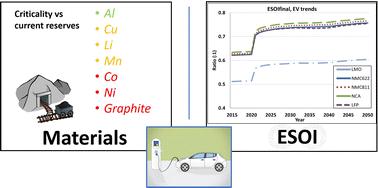当前位置:
X-MOL 学术
›
Energy Environ. Sci.
›
论文详情
Our official English website, www.x-mol.net, welcomes your
feedback! (Note: you will need to create a separate account there.)
Material and energy requirements of transport electrification
Energy & Environmental Science ( IF 32.4 ) Pub Date : 2022-10-28 , DOI: 10.1039/d2ee00802e Daniel Pulido-Sánchez 1 , Iñigo Capellán-Pérez 1, 2 , Carlos de Castro 1, 3 , Fernando Frechoso 1, 4
Energy & Environmental Science ( IF 32.4 ) Pub Date : 2022-10-28 , DOI: 10.1039/d2ee00802e Daniel Pulido-Sánchez 1 , Iñigo Capellán-Pérez 1, 2 , Carlos de Castro 1, 3 , Fernando Frechoso 1, 4
Affiliation

|
The replacement of internal combustion engines by electric vehicles (EVs) is being promoted towards the decarbonisation of the transportation sector. EVs require important amounts of materials, some of which are being assessed as potentially critical in the future. In this work, we develop a submodule of material requirements for transport for an integrated assessment model with great detail in the representation of electric transportation modes. This submodule includes the following novel characteristics: a portfolio of EV battery subtechnologies (LMO, NMC622, NMC811, NCA & LFP) and EV chargers, including the required connections to the grid; comprehensive coverage of their material intensities; and a dynamic allocation function for EV battery subtechnologies, taking into account the changes over time of their Energy Stored Over energy Invested (ESOI) and material scarcities. We obtain ESOIst levels for household 4-wheelers in the range of 1.1–2.3 : 1 depending on the subtechnology, and lower than 1 : 1 for all subtechnologies when expanding the boundaries (ESOIfinal) to include grids and chargers. The NCA and NMC subtechnologies are the best performing options in terms of ESOI; however, they are more dependent on critical materials such as nickel, cobalt and manganese. Expanding the boundaries to include chargers significantly increases the GHG footprint of EVs. The integration of these features into a dynamic modelling framework, including the demand of materials from the rest of the economy, allows us to analyse different decarbonisation strategies, taking into account the feedback between the energy and material dimensions. Simulating the MEDEAS-World model including the developed submodule until 2050 for 3 different global transport transition strategies, we find that reserves of copper (with significant contributions from EV chargers and railways), cobalt, lithium, manganese, nickel and graphite would be depleted in at least one of the scenarios studied. The Degrowth scenario puts less pressure on material endowments. Recycling is an important strategy to reduce criticalities, but its effectiveness is limited as the materials are trapped for long time periods in stocks in-use in the system, which is worsened by the growth-oriented nature of the current economic paradigm.
中文翻译:

交通电气化的材料和能源要求
电动汽车(EV)取代内燃机正在推动交通部门的脱碳。电动汽车需要大量材料,其中一些材料被评估为未来可能至关重要。在这项工作中,我们开发了一个运输材料需求的子模块,用于一个综合评估模型,非常详细地表示电动交通模式。该子模块包括以下新特性: EV 电池子技术组合(LMO、NMC622、NMC811、NCA 和 LFP)和 EV 充电器,包括所需的电网连接;全面覆盖其物质强度;以及电动汽车电池子技术的动态分配函数,考虑到他们的能量存储超过能量投资 (ESOI) 和材料稀缺性随时间的变化。我们获得 ESOI家用四轮车的st水平在 1.1-2.3 : 1 的范围内,取决于子技术,在扩展边界时,所有子技术低于 1:1(ESOI最终) 包括电网和充电器。NCA 和 NMC 子技术是 ESOI 方面表现最好的选择;然而,它们更依赖于镍、钴和锰等关键材料。扩大边界以包括充电器会显着增加电动汽车的温室气体排放量。将这些特征整合到一个动态建模框架中,包括其他经济体对材料的需求,使我们能够分析不同的脱碳策略,同时考虑到能源和材料维度之间的反馈。模拟 MEDEAS-World 模型,包括到 2050 年针对 3 种不同的全球交通转型战略开发的子模块,我们发现铜(电动汽车充电器和铁路贡献显着)、钴、锂、锰、在所研究的至少一种情景中,镍和石墨将被耗尽。衰退情景对物质禀赋的压力较小。回收是降低临界值的重要策略,但其有效性有限,因为材料长期被困在系统中使用的库存中,而当前经济模式以增长为导向的性质使情况恶化。
更新日期:2022-11-02
中文翻译:

交通电气化的材料和能源要求
电动汽车(EV)取代内燃机正在推动交通部门的脱碳。电动汽车需要大量材料,其中一些材料被评估为未来可能至关重要。在这项工作中,我们开发了一个运输材料需求的子模块,用于一个综合评估模型,非常详细地表示电动交通模式。该子模块包括以下新特性: EV 电池子技术组合(LMO、NMC622、NMC811、NCA 和 LFP)和 EV 充电器,包括所需的电网连接;全面覆盖其物质强度;以及电动汽车电池子技术的动态分配函数,考虑到他们的能量存储超过能量投资 (ESOI) 和材料稀缺性随时间的变化。我们获得 ESOI家用四轮车的st水平在 1.1-2.3 : 1 的范围内,取决于子技术,在扩展边界时,所有子技术低于 1:1(ESOI最终) 包括电网和充电器。NCA 和 NMC 子技术是 ESOI 方面表现最好的选择;然而,它们更依赖于镍、钴和锰等关键材料。扩大边界以包括充电器会显着增加电动汽车的温室气体排放量。将这些特征整合到一个动态建模框架中,包括其他经济体对材料的需求,使我们能够分析不同的脱碳策略,同时考虑到能源和材料维度之间的反馈。模拟 MEDEAS-World 模型,包括到 2050 年针对 3 种不同的全球交通转型战略开发的子模块,我们发现铜(电动汽车充电器和铁路贡献显着)、钴、锂、锰、在所研究的至少一种情景中,镍和石墨将被耗尽。衰退情景对物质禀赋的压力较小。回收是降低临界值的重要策略,但其有效性有限,因为材料长期被困在系统中使用的库存中,而当前经济模式以增长为导向的性质使情况恶化。











































 京公网安备 11010802027423号
京公网安备 11010802027423号